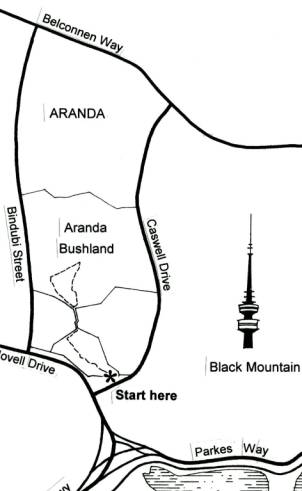
Friends of the Aranda Bushland Inc
Frost Hollow to Forest Education Kit
phone– 6251–1345, fax 6251 7621,email mefalconer@home.netspeed.com.au

Friends of the Aranda Bushland Inc
Frost Hollow to Forest Education Kit
phone– 6251–1345, fax 6251 7621,email mefalconer@home.netspeed.com.au
Frost Hollow to Forest Walk
Canberra has rich flora, birdlife, frogs, reptiles and kangaroos within easy access of city and suburbs.
This self-guided walk introduces you to treeless grasslands, remnant Snow Gums, Yellow Box-Red Gum woodland and Aranda Bushland’s forest.

The walk is 1 to 2 hours with stiles and a short uphill grade:
Experience the beauty and diversity of our natural environment and appreciate our inheritance from early planners of Canberra - a city in sympathy with the colours and ambience of the Australian bush.
Use the interpretive signs with clear drawings to discover ten eucalypt species and see how each has its own place in the ecology.
See treeless frost hollow grasslands and remnant Snow Gums lining the frost hollow edge.
Walk up through a forest of dark-trunked eucalypts, then turn and see white trunks.
Enjoy wildflowers in season; look and listen for frogs, birds and kangaroos.
Signs will walk you through ten eucalypt species and four ecological communities.
This is a magic area on a clear frosty morning, at times white to the grasslands’ edge. Sometimes fog drifts and visibility is only two cars ahead.
The paddocks of native grass are the soft khaki characteristic of the Australian bush west of the Great Divide. The colour deepens as the seeds ripen in the late summer - an Australian icon celebrated in Arthur Streeton's paintings.
Frost hollows occur when cold air drains to the lowest ground and stays in a pool of significantly colder air. Grasses dominate as it’s too cold for trees and shrubs to establish naturally. Diversity in this environment is best appreciated in early summer with many grassland wildflowers.
A pocket of remnant Snow Gums (Eucalyptus pauciflora) lines the frost hollow. Snow Gums are the most cold tolerant eucalypt. Aranda Snow Gums is listed as a Heritage Place, being the best Canberra example of a frost hollow with its native vegetation largely intact.
See the magnificent Yellow Box-Red Gum grassy woodland - characteristic gums of open paddocks. Notice all the hollows in these 250+ year old trees. Hollows may take over 100 years to form and are essential habitat for nesting birds and possums.
Experience the distinct change in vegetation as you enter Aranda Bushland’s forest. The trees grow close together and are much the same age. Parts were cleared by early settlers but large areas regenerated naturally before today’s major weeds invaded.
The winding uphill route takes you through dark-trunked eucalypts and the downhill track through white-trunked ones. Consider how Arthur Boyd captured their essence in his Parliament House tapestry. For a magic photo, catch the white trunks when the light is slanted and the bark is newly shed in late summer.
Big weeding parties in 1992 cleared tangles of hawthorn and briar along the bottom Aranda Bushland road and follow-up weeding continues. See how well the bush has regenerated naturally.
Making this self guided walk
This walk was developed by Friends of Aranda Bushland, a parkcare group operating with the support of ACT Parks and Conservation Service. The walk complements our photographic field guide Our Patch which covers wildflowers, trees and grasses.
Natural Heritage Trust grants from 1999 to 2001 funded fencing and signs. Environment ACT provided support, graphic design funds and installation.
Neville and Hazel Stuart’s permission to fence a corridor through their Glenloch rural lease to link the Snow Gums to Aranda Bushland made the self guided walk a reality.
Friends of Aranda Bushland Inc
19 November 2004
Download a copy of this document
Find out more
Our website: www.friendsofarandabushland.org.au
Our Patch; field guide to the flora of the Australian Capital Region as photographed in the Aranda Bushland. Friends of Aranda Bushland, 1997. 91 pages.
A guide to eucalyptus in the ACT. Peter Ormay for ACT Parks & Conservation, 1990, pamphlet.
Black Mountain wildflower walks. Field Naturalists Assn, Australian Native Plants Society, Telstra, 3 or 4 annual pamphlets.
Canberra Nature Park; bush on your doorstep. Ian Fraser & Environment ACT, 2004. Map.
Field guide to the native trees of the ACT. National Parks Assn ACT, 1990. 99 p.
Grassland flora, a field guide for the Southern Tablelands (NSW & ACT), David Eddy, Dave Mallinson, Rainer Rehwinkel, Sarah Sharp, 1998. 156 p.
Field guide to birds of the ACT, McComas Taylor, Nicolas Day. National Parks Assn. ACT, 1993. 90 p.
Wild about Canberra, Ian Fraser and Margaret McJannett. ACT Parks & Conservation, 1993. 114 p.
Trees and shrubs of Black Mountain, Mt Ainslie and Mt Majura, a key based on vegetative characters, Laurence G Adams. CSIRO, 1990. 24 p.
Reptiles and frogs of the ACT, Ross Bennett. National Parks Assn. ACT, 1997. 86p.
Australian National Botanic Gardens: world’s best collection of Australian native plants, together with herbarium specimens from Our Patch, the Botanical Bookshop and photos from Our Patch on www.anbg.gov.au.
Maps of Aranda Bushand and other nature reserves in Canberra Nature Park are on www.environment.act.gov.au